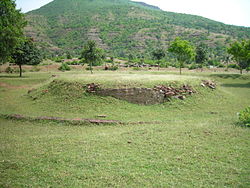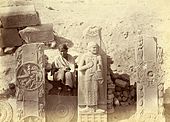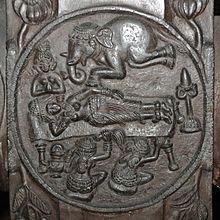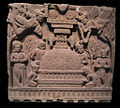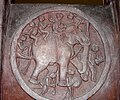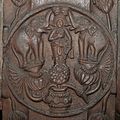Bharhut
| Bharhut भरहुत |
||
|---|---|---|
|
|
||
| State : |
|
|
| State : | Madhya Pradesh | |
| District : | Satna | |
| Sub-district : | Unchehara | |
| Location : | 24 ° 27 ' N , 80 ° 53' E | |
| Height : | 310 m | |
| Area : | 9.35 km² | |
| Residents : | 2,100 (2011) | |
| Population density : | 225 inhabitants / km² | |
| Ruins of the stupa of Bharhut | ||
Bharhut or Bharhat (Hindi: भरहुत) is a village with approx. 2,100 inhabitants in the municipality ( tehsil ) of Unchehara in the Satna district in the central Indian state of Madhya Pradesh . The small town became famous for the Buddhist stupa from the 3rd and 2nd centuries BC, which was discovered here at the end of the 19th century . BC, whose vedika pieces made of relief- coated and polished dark red sandstone are mostly kept and shown in the Indian Museum in Kolkata .
location
The village of Bharhut is located at an altitude of about 310 m in a hilly landscape in the central Indian district of Satna . The district capital and the train station of Satna are about 25 km (driving distance) to the north.
history
The Bharhut stupa is dated to the 3rd century BC. BC, i.e. dated to the time of the Maurya ruler Ashoka . The stone fence was probably built around a century later during the Shunga dynasty . The most recent finds date from medieval times (approx. 10th century); It is unclear whether the stupa still existed in an intact condition at the time. During the time of Islam's dominance over large parts of northern India, the place of worship was forgotten, perhaps even deliberately destroyed. Later, the residents of the surrounding villages took stone material to build their houses. In 1873, Alexander Cunningham , director of the Archaeological Survey of India , visited the ruins; the following year excavation work began.
Stupa
According to Cunningham, the stupa of Bharhut had a diameter of almost 68 feet (= approx. 20.70 m) and was therefore only slightly smaller than the large stupa of Sanchi ; its height should have been about 8-10 m, of which only about 1.50 m is left. The hill, which was made entirely of burnt bricks, was probably covered with natural stones or stone slabs and a small fence border ( harmika ) with an honorary umbrella ( chhatri ) formed its top crown. In the original period there were no reliefs near it; The stupa, which symbolizes the cosmos or Buddha itself, was venerated by a clockwise conversion ceremony ( pradakshina ).
Vedika

An outstanding achievement of early Buddhist art , but also of all Indian art, is the manual processing and sculptural design of the stone fence ( vedika ) that once surrounded the stupa . This consists of dark red sandstone and has a diameter of a good 88 feet (= approx. 26.90 m); On the one hand it protected the stupa from free-roaming cattle and other animals, on the other hand it formed a kind of 'sacred area', within which monks and other high-ranking visitors could transform the stupa ( pradakshina ) undisturbed, including touching it. The stone fence had four entrance gates ( toranas ) oriented in the four cardinal directions and not angled, each with three stone crossbeams with rolled ends, one above the other. The two lower crossbeams were connected to one another by small ornamental columns , some of which were replaced by figures .
The round or semicircular reliefs of the stone fence mostly show abstract or floral motifs, but also some water monsters ( makaras ), scenic representations and human busts can be seen; Several roughly square relief panels with scenes from Buddhist legends and stories ( jatakas ) can be found in the area of the entrance gates. The main posts usually show male and female figures - e.g. Sometimes with hands crossed in front of the chest or clasped together. The smaller posts of the vedika are often adorned with small yakshi or salabhanjika figures on the sides.
Due to the intensive polishing of the stones, the reliefs were given a shine that - despite various damage - is still there after over 2000 years and deeply impresses every viewer.
Stone relief with yakshi
Gayalakshmi Medallion
Tree nymph ( salabhanjika )
temple
During the excavations, a small temple building dating from around 1000 AD, but can only be seen in photographs, with a seated, unfortunately headless Buddha figure with the hand gesture ( mudra ) of invoking the earth ( bhumisparshamudra ), which is framed is made up of lateral torana pillars with figural reliefs of the Hindu gods of heaven (e.g. Shiva , Brahma and Indra ).
literature
- Alexander Cunningham : The Stu-Pa of Bharhut. A Buddhist Monument Ornamented with Numerous Sculptures Illustrative of Buddhist Legend and History in the Third Century BC Hardpress Publ., London 2013. (Reprint of the first edition from 1879)
- Heino Kottkamp: The stupa as a representation of the Buddhist way of salvation. Investigations into the origin and development of architectural symbolism. Harrassowitz, Wiesbaden 1992, ISBN 3-447-03306-1 .
- Adrian Snodgrass: The symbolism of the stupa. Motilal Banarsidass, Delhi 1992, ISBN 81-208-0781-2 .
- Johannes W. Glauche: The stupa. Cult building of Buddhism. DuMont, Cologne 1995, ISBN 3-7701-3018-9 .
Web links
- Bharhut stupa - photos + detailed information (Jatland Wiki, English)
- Bharhut Stupa, reliefs - Photos and detailed information (English)
- Bharhut department in the Indian Museum in Kolkata - Photo of the stone fence (vedika)
- Bharhut, Temple - Photo + info (English)
- Bharhut, tablet - photo + information (English)
- Head of a statue from Bharhut - photo

